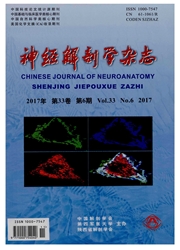

 中文摘要:
中文摘要:
为探讨导致神经元病理改变的可能机制以进行干预治疗,本研究采用组织学、免疫组织化学、免疫荧光组织化学及免疫印记等技术对C型Niemann-Pick病(NPC)小鼠(npc-1小鼠)的神经病理、细胞骨架蛋白及细胞周期M期标志进行了研究。结果显示:在npc-1小鼠脑干、小脑白质、基底神经节及大脑白质有诸多神经元含脂质沉积并有球状神经轴突形成。这些异常的神经轴突内含有大量的异常磷酸化的细胞骨架蛋白tau及神经丝蛋白NF。M期标志物的存在表明有丝分裂激酶活化参与这一病理结构的形成过程。本文结果提示:神经元骨架蛋白的异常磷酸化对npc-1小鼠神经病理的形成过程有重要作用,有丝分裂激酶异常活化可能导致这些骨架蛋白的异常磷酸化。针对这一发现可设计干预方案来阻止神经元变性过程。
 英文摘要:
英文摘要:
In order to elucidate the neuropathogenesis and seek for intervention methods for Niemann-Pick disease type C (NPC) , histological, immunohistochemical and immunoblotting methods were performed to detect the neuropathologieal and cytoskeletal changes as well as the presence of mitotic, markers which are considered to be the early markers of neurodegeneration in a murine model of NPC. The results revealed that in npc-1 mouse brain, many enlarged neurons containing lipids, pathological axonal spheroids were found in the white matter of the brainstem, cerehellum, basal ganglion and the forebrain. Within the axonal spheroids, abnormally hyperphosphorylated tau and neurofilaments were strongly stained with specific antibodies respectively. Furthermore, the presence of mitotic markers including cdc2/cyclin BI, MPM-2 and H-5 in the axonal spheroids implies that the activation of mitotic kinase plays an important role in axonal spheroid formation. The present study indicates that ahnormal hyperphosphorylation of the neuronal cytoskeletal proteins constitutes an important event in pathogenesis of npc-1 mouse brain pathology. The abnormal activation of mitotic kinase may be the corresponding factor for the hyperphos-phorylation of cytoskeletal proteins in the post-mitotic neurons. The study may suggest a new way for intervening the degenerating process by targeting the cytoskelctal pathology.
 同期刊论文项目
同期刊论文项目
 同项目期刊论文
同项目期刊论文
 期刊信息
期刊信息
